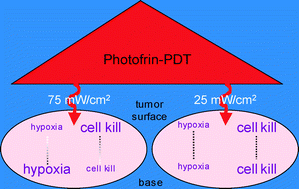Fluence rate-dependent intratumor heterogeneity in physiologic and cytotoxic responses to Photofrin photodynamic therapy†
Abstract
Photodynamic therapy (PDT) can lead to the creation of heterogeneous, response-limiting hypoxia during illumination, which may be controlled in part through illumination fluence rate. In the present report we consider (1) regional differences in hypoxia, vascular response, and cell kill as a function of tumor depth and (2) the role of fluence rate as a mediator of depth-dependent regional intratumor heterogeneity. Intradermal RIF murine tumors were treated with Photofrin PDT using surface illumination at an irradiance of 75 or 38 mW cm−2. Regional heterogeneity in tumor response was examined through comparison of effects in the surface vs. base of tumors, i.e. along a plane parallel to the skin surface and perpendicular to the incident illumination. 75 mW cm−2 PDT created significantly greater hypoxia in tumor bases relative to their surfaces. Increased hypoxia in the tumor base could not be attributed to regional differences in Photofrin concentration nor effects of fluence rate distribution on photochemical oxygen consumption, but significant depth-dependent heterogeneity in vascular responses and cytotoxic response were detected. At a lower fluence rate of 38 mW cm−2, no detectable regional differences in hypoxia or cytotoxic responses were apparent, and heterogeneity in vascular response was significantly less than that during 75 mW cm−2 PDT. This research suggests that the benefits of low-fluence-rate PDT are mediated in part by a reduction in intratumor heterogeneity in hypoxic, vascular and cytotoxic responses.


 Please wait while we load your content...
Please wait while we load your content...